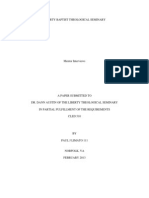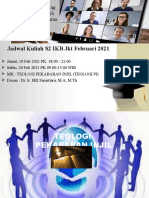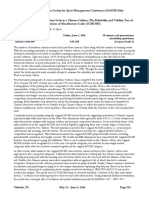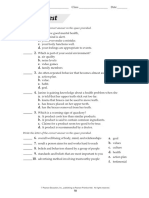The Magic of Learner Motivation: The ARCS Model: by Kevin Kruse
The Magic of Learner Motivation: The ARCS Model: by Kevin Kruse
Uploaded by
Gerson PandieCopyright:
Available Formats
The Magic of Learner Motivation: The ARCS Model: by Kevin Kruse
The Magic of Learner Motivation: The ARCS Model: by Kevin Kruse
Uploaded by
Gerson PandieOriginal Title
Copyright
Available Formats
Share this document
Did you find this document useful?
Is this content inappropriate?
Copyright:
Available Formats
The Magic of Learner Motivation: The ARCS Model: by Kevin Kruse
The Magic of Learner Motivation: The ARCS Model: by Kevin Kruse
Uploaded by
Gerson PandieCopyright:
Available Formats
The Magic of Learner Motivation: The ARCS Model
by Kevin Kruse Motivation is the most overlooked aspect of instructional strategy, and perhaps the most critical element needed for employee-learners. Even the most elegantly designed training program will fail if the students are not motivated to learn. Without a desire to learn on the part of the student, retention is unlikely. Many students in a corporate setting who are forced to complete training programs are motivated only to "pass the test." Designers must strive to create a deeper motivation in learners for them to learn new skills and transfer those skills back into the work environment. As a first step, instructional designers should not assume they understand the target audience's motivation. To analyze needs, the designer should ask prospective learners questions such as: What would the value be to you from this type of program? What do you hope to get out of this program? What are your interests in this topic? What are you most pressing problems?
The answers to these types of questions are likely to provide insight into learner motivation, as well as desirable behavioral outcomes. Keller's ARCS Model for Motivation John Keller synthesized existing research on psychological motivation and created the ARCS model (Keller, 1987). ARCS stands for Attention, Relevance, Confidence, and Satisfaction. This model is not intended to stand apart as a separate system for instructional design, but can be incorporated within Gagne's events of instruction. Attention The first and single most important aspect of the ARCS model is gaining and keeping the learner's attention, which coincides with the first step in Gagne's model. Keller's strategies for attention include sensory stimuli (as discussed previously), inquiry arousal (thought provoking questions), and variability (variance in exercises and use of media). Relevance Attention and motivation will not be maintained, however, unless the learner believes the training is relevant. Put simply, the training program should answer the critical question, "What's in it for me?" Benefits should be clearly stated. For a sales training program, the benefit might be to help representatives increase their sales and personal commissions. For a safety training program, the benefit might be to reduce the number of workers getting hurt. For a software training program, the benefit to users could be to make them more productive or reduce their frustration with an application. A healthcare program might have the benefit that it can teach doctors how to treat certain patients. Confidence The confidence aspect of the ARCS model is required so that students feel that they should put a good faith effort into the program. If they think they are incapable of achieving the objectives or that it will take too much time or effort, their motivation will decrease. In technologybased training programs, students should be given estimates of the time required to complete lessons or a measure of their progress through the program. Satisfaction Finally, learners must obtain some type of satisfaction or reward from the learning experience. This can be in the form of entertainment or a sense of achievement. A selfassessment game, for example, might end with an animation sequence acknowledging the player's high score. A passing grade on a post-test might be rewarded with a completion
certificate. Other forms of external rewards would include praise from a supervisor, a raise, or a promotion. Ultimately, though, the best way for learners to achieve satisfaction is for them to find their new skills immediately useful and beneficial on their job. The success or failure of any e-learning initiative can be closely corrolated to learner motivation. Remebers the ARCS model when designing any program.
You might also like
- C1. A Manual of Theological Curriculum Development Complete WEB VDocument60 pagesC1. A Manual of Theological Curriculum Development Complete WEB VPaulCJBurgess50% (2)
- Advanced Maintenance ManagementDocument3 pagesAdvanced Maintenance ManagementMohammed Al-OdatNo ratings yet
- Thomas LickonaDocument8 pagesThomas LickonaHEMAWATHY A/P ARUMUGAMNo ratings yet
- Mentor Interviews CLED510Document9 pagesMentor Interviews CLED510aletheiaodu100% (1)
- Christian Education Curriculum for the Digital Generation: A Case Study of Second-Generation Korean Australian YouthFrom EverandChristian Education Curriculum for the Digital Generation: A Case Study of Second-Generation Korean Australian YouthNo ratings yet
- Disciples Path The Journey Vol2 SampleDocument15 pagesDisciples Path The Journey Vol2 SampleZORAN10No ratings yet
- 1 LECTURA OBLIGATORIA Kluszczyński Sculpting Time - The Art of Collective Memory FinalDocument17 pages1 LECTURA OBLIGATORIA Kluszczyński Sculpting Time - The Art of Collective Memory FinalSarita RamirezNo ratings yet
- Quiz 1 Organization BehaviorDocument3 pagesQuiz 1 Organization Behaviorroslinawati_ismailNo ratings yet
- Development of Christian Character Education Based Project Based Learning Teaching Materials To Improve Student CharacterDocument9 pagesDevelopment of Christian Character Education Based Project Based Learning Teaching Materials To Improve Student CharacterIJELS Research JournalNo ratings yet
- One Thing Is Needful Weekly Devotional Guide: 52 doses of Scriptural insights to enrich your walk with God throughout the yearFrom EverandOne Thing Is Needful Weekly Devotional Guide: 52 doses of Scriptural insights to enrich your walk with God throughout the yearNo ratings yet
- Rekonstruksi Epistemologi Studi Islam PDFDocument15 pagesRekonstruksi Epistemologi Studi Islam PDFNishful QolbyNo ratings yet
- Konsep Memilih Pasangan Hidup Menurut 2 Korintus 614-15 Dan Aplikasinya Terhadap Pencegahan Perkawinan Beda AgamaDocument15 pagesKonsep Memilih Pasangan Hidup Menurut 2 Korintus 614-15 Dan Aplikasinya Terhadap Pencegahan Perkawinan Beda AgamaNanda YonataNo ratings yet
- Questions of Business Life - Exploring Workplace Issues From A Christian Perspective (2002)Document145 pagesQuestions of Business Life - Exploring Workplace Issues From A Christian Perspective (2002)ronald young100% (1)
- Better Christian EducationDocument57 pagesBetter Christian EducationEmmanuel BahadurNo ratings yet
- Chapter 1Document46 pagesChapter 1bahmud mohammed100% (1)
- ChurchGrowthStateoftheArt (ETowns)Document205 pagesChurchGrowthStateoftheArt (ETowns)Efe OmorakaNo ratings yet
- Pedagogy vs. Andragogy: A False Dichotomy? ReviewDocument1 pagePedagogy vs. Andragogy: A False Dichotomy? ReviewPuple Revita LampadNo ratings yet
- VUCA: Steering Wheel Towards SuccessDocument1 pageVUCA: Steering Wheel Towards SuccessDiana Ruth Guzon HabloNo ratings yet
- Teologi Pekabaran InjilDocument23 pagesTeologi Pekabaran InjilBayu HartantoNo ratings yet
- Discipleship in The New TestamentDocument4 pagesDiscipleship in The New Testamentchris iyaNo ratings yet
- Biblical IntegrationDocument42 pagesBiblical IntegrationWastepayNo ratings yet
- Behavioural Excess Is An Undesirable Target Behaviour The Person Wants To Decrease in FrequencyDocument10 pagesBehavioural Excess Is An Undesirable Target Behaviour The Person Wants To Decrease in FrequencyGodwin EzekielNo ratings yet
- Counselling Mod 2Document85 pagesCounselling Mod 2atleyjoechacko22No ratings yet
- Teacher Evaluation - Catholic Education Standards RubricDocument3 pagesTeacher Evaluation - Catholic Education Standards Rubricapi-272379696No ratings yet
- PsychologyDocument228 pagesPsychologye70760279No ratings yet
- Biblical Integration in A Mathematics Classroom QuDocument9 pagesBiblical Integration in A Mathematics Classroom QuDaveNo ratings yet
- Reading Report 1 Pastoral Care and CounselingDocument2 pagesReading Report 1 Pastoral Care and CounselingVeli-Lauri Kotilainen100% (1)
- The Discipleship Strategy of JesusDocument2 pagesThe Discipleship Strategy of JesussobtrueNo ratings yet
- Educational Organization Management System A Complete Guide - 2020 EditionFrom EverandEducational Organization Management System A Complete Guide - 2020 EditionNo ratings yet
- RPS Mata Kuliah Public Speaking IUPDocument4 pagesRPS Mata Kuliah Public Speaking IUPSties mkNo ratings yet
- The Pure Cell Model Compared With The Metachurch Model by Joel ComiskeyDocument19 pagesThe Pure Cell Model Compared With The Metachurch Model by Joel ComiskeyDavid KabwamaNo ratings yet
- A Christian View of Money: Celebrating God’s Generosity (4th edition)From EverandA Christian View of Money: Celebrating God’s Generosity (4th edition)No ratings yet
- What Does It Mean For A Discipline To Be A Science?Document3 pagesWhat Does It Mean For A Discipline To Be A Science?Pablo Recinos100% (1)
- Jurnal KristologiDocument14 pagesJurnal Kristologisabar giawaNo ratings yet
- Impact of Motivation On Teachers' Job PerformanceDocument19 pagesImpact of Motivation On Teachers' Job PerformanceJay GalangNo ratings yet
- The Nature of Discipleship Leaders RevisedDocument23 pagesThe Nature of Discipleship Leaders Revisedchris iya100% (1)
- Helps To Holy Living - Charles OrrDocument19 pagesHelps To Holy Living - Charles OrrKenneth OkoyeNo ratings yet
- Discipleship Matters:Learning from Timothy's Spiritual JourneyFrom EverandDiscipleship Matters:Learning from Timothy's Spiritual JourneyNo ratings yet
- Lectura Smith - ReviewOsmer. Practical Theolgy. Richard Osmer.Document15 pagesLectura Smith - ReviewOsmer. Practical Theolgy. Richard Osmer.Giovanny Alexander Vargas AvendañoNo ratings yet
- Theology AssignmentDocument2 pagesTheology AssignmentVenitoNo ratings yet
- Peter Carlos Okantey - Jesus, The Originator of Servant LeadershipDocument11 pagesPeter Carlos Okantey - Jesus, The Originator of Servant LeadershipMorris Supit100% (1)
- Different Approaches and MethodsDocument74 pagesDifferent Approaches and MethodsEllie BunNo ratings yet
- Mentoring EBookDocument16 pagesMentoring EBookAlketa ZakaNo ratings yet
- Introduction To The New Testament: Syllabus, Spring 2016Document8 pagesIntroduction To The New Testament: Syllabus, Spring 2016Reverson MenorNo ratings yet
- Fowler - Stages of FaithDocument16 pagesFowler - Stages of FaithGede CsongorNo ratings yet
- IS TRANSFORMATIONAL LEADERSHIP IDEAL FOR PUBLIC HEALTH SECTOR HEALTH CARE ORGANISATIONS by Reason ChivakaDocument8 pagesIS TRANSFORMATIONAL LEADERSHIP IDEAL FOR PUBLIC HEALTH SECTOR HEALTH CARE ORGANISATIONS by Reason ChivakachivconNo ratings yet
- Formation for Transformation: An Approach to Renewing the Teaching Ministry within the ChurchFrom EverandFormation for Transformation: An Approach to Renewing the Teaching Ministry within the ChurchNo ratings yet
- Kepemimpinan Yesus Teladan Pemimpin Masa KiniDocument14 pagesKepemimpinan Yesus Teladan Pemimpin Masa KiniHarol GobaiNo ratings yet
- Re-Imagining Christian Education for the Twenty-First CenturyFrom EverandRe-Imagining Christian Education for the Twenty-First CenturyNo ratings yet
- Biblical TheologyDocument4 pagesBiblical TheologyRev'd ThankGod OderotorNo ratings yet
- 978 3 319 63248 3 - 3 Exploring Relations Between FormativeDocument28 pages978 3 319 63248 3 - 3 Exploring Relations Between FormativefidyaNo ratings yet
- Cultivating Your Inner Life Through Obedience and Total SurrenderDocument6 pagesCultivating Your Inner Life Through Obedience and Total SurrenderSheina Marie OnrubiaNo ratings yet
- Educ310 - Intro To Christian Education 13Document23 pagesEduc310 - Intro To Christian Education 13api-235676891No ratings yet
- Learning Agility - in Search of Conceptual Clarity and Theoretical Grounding 2Document27 pagesLearning Agility - in Search of Conceptual Clarity and Theoretical Grounding 2tomaslealeNo ratings yet
- ReopeningChurch Guide r4Document26 pagesReopeningChurch Guide r4hmareidNo ratings yet
- Psychology Unit 1Document83 pagesPsychology Unit 1anjalikumarisah518No ratings yet
- Neves Ana C 200911 MA ThesisDocument189 pagesNeves Ana C 200911 MA ThesisMaimbo100% (1)
- Neuro-Fuzzy SystemDocument6 pagesNeuro-Fuzzy SystemGaurav KumarNo ratings yet
- The Relativistic Brain by Ronald Cicurel and Miguel L. Nicolelis (2015)Document5 pagesThe Relativistic Brain by Ronald Cicurel and Miguel L. Nicolelis (2015)Sinem SerapNo ratings yet
- Research (Outline)Document27 pagesResearch (Outline)jsthrNo ratings yet
- Character Formation With Leadershop, Decision Making, Management and Administration (CFLM 2) Prepared By: Jejie M. Awit., LPTDocument22 pagesCharacter Formation With Leadershop, Decision Making, Management and Administration (CFLM 2) Prepared By: Jejie M. Awit., LPTEddie Mamusog Awit100% (3)
- Feldenkrais PDFDocument22 pagesFeldenkrais PDFshrinidhik@gmailcomNo ratings yet
- Multiple Choice Questions: Strategic ManagementDocument25 pagesMultiple Choice Questions: Strategic ManagementAbhiram Kotthas100% (1)
- Adler Individual PsychologyDocument11 pagesAdler Individual Psychologyemd06100% (1)
- MBTI Text PDFDocument5 pagesMBTI Text PDFSanchitKumarNo ratings yet
- Group#1 Fundamentals of Group DynamicsDocument18 pagesGroup#1 Fundamentals of Group DynamicsRikka Takanashi100% (4)
- Operational Safety:-A New Frontier in Dam Safety ManagementDocument20 pagesOperational Safety:-A New Frontier in Dam Safety ManagementMarcelo ProtzNo ratings yet
- Final Grad-H.MDocument21 pagesFinal Grad-H.Mnarasimha raoNo ratings yet
- Marketing Friday, June 3, 2016 20-Minute Oral Presentation (Including Questions) Abstract 2016-099 8:50 AM (Legacy South 2)Document2 pagesMarketing Friday, June 3, 2016 20-Minute Oral Presentation (Including Questions) Abstract 2016-099 8:50 AM (Legacy South 2)Luiz SilvaNo ratings yet
- John Michael Greer - The Magical Lodge - Part 1Document2 pagesJohn Michael Greer - The Magical Lodge - Part 1liboanino100% (1)
- Schema Theory NarrativeDocument5 pagesSchema Theory Narrativeapi-188978784100% (1)
- A Study of Kevin Kelly's Out of Control'Document20 pagesA Study of Kevin Kelly's Out of Control'Laura Cristina Herrera IsazaNo ratings yet
- TQM CO PEOsDocument4 pagesTQM CO PEOsHarish GVNo ratings yet
- Social Connectedness and Role of HopelessnessDocument8 pagesSocial Connectedness and Role of HopelessnessEmman CabiilanNo ratings yet
- Uriah Kriegel - The Sources of Intentionality - (Philosophy of Mind Series) Oxford University Press (2014)Document286 pagesUriah Kriegel - The Sources of Intentionality - (Philosophy of Mind Series) Oxford University Press (2014)Sebastian Castañeda PalaciosNo ratings yet
- Course Manual CBDocument22 pagesCourse Manual CBIshan SahniNo ratings yet
- Note Guidance and CounselingDocument22 pagesNote Guidance and CounselingjvnNo ratings yet
- Regulatory Depletion PatternsDocument16 pagesRegulatory Depletion PatternsMusinautaNo ratings yet
- CH 1 TestDocument2 pagesCH 1 TestGabriel GarnicaNo ratings yet
- G W F Hegel, The Philosophy of Spirit 1805-6, Jena LecturesDocument96 pagesG W F Hegel, The Philosophy of Spirit 1805-6, Jena LecturesglyphodendNo ratings yet
- Competency PresentationDocument41 pagesCompetency Presentationapi-449352909No ratings yet
- Tuckman's Stages of Group Development: Introduction: The Model Describes Inevitable andDocument11 pagesTuckman's Stages of Group Development: Introduction: The Model Describes Inevitable andSuman KumarNo ratings yet
- Analysis and Control of Underactuated Mechanical SystemsDocument148 pagesAnalysis and Control of Underactuated Mechanical SystemsDjelejnyNo ratings yet
- Theories of SelfDocument5 pagesTheories of SelfKissha Jane100% (1)

























































































